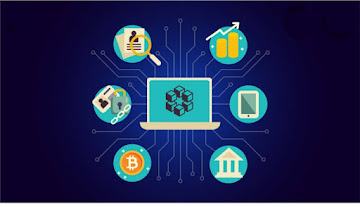Blockchain
Blockchain
What is blockchain?
A blockchain is a collection of encrypted information stored electronically in a digital format.Data held in the blockchain spreads out among several users at various locations through network nodes.
Blockchain plays a crucial role in cryptocurrency for maintaining a secure and decentralized record of transactions. As it generates fidelity among users without involvement of a third party.
Why use blockchain?
A point of difference between a database and a blockchain is the structure of its data.
A database structures data into tables whereas a blockchain structures data into blocks that are strung together in a chronological order. This structure inherently makes an irreversible timeline when implemented in a decentralized environment. When a block is filled it becomes a part of the chain. Each block in the chain is notified with an exact timestamp when it is added to the chain.Blocks are linked together via cryptography.
For example, Suppose a company owns a server farm with 2,000 computers installed with the purpose to maintain a database of all its users. All the information is stored under one roof and the company has full control over each computer and information. However, Even such a controlled environment has several points of failure like failure of electricity, internet, backup protocols.What if it all burns to the ground or someone erases or replicates everything with a single keystroke?.In any such case data is lost or corrupted.
Whereas in a blockchain data is held at several points of location through nodes of the network. It creates redundancy and maintains fidelity of the data stored. Different types of information can be stored on a blockchain. So far, the most common use of blockchain is Ledger for transactions.
As in the Bitcoin, Blockchain is used in a decentralized fashion so that no single person or group has control. All its users collectively retain control. For Bitcoin is an immutable decentralized blockchain which means all transactions are permanently recorded and viewable for anyone.
Is blockchain safe?
Blockchain serves the purpose of recording information which can be further distributed but cannot be altered. That's why the use of blockchain has exploded by creation of various cryptocurrencies, decentralized finance (DeFi) applications, non-fungible tokens (NFTs), and smart contracts.
If a user tampers through Bitcoin’s record of transactions, all other nodes would cross-reference each other and can easily pinpoint the node with the incorrect match of information. This system helps to establish an exact and transparent order of events.
In order to validate new entries into a block, a majority of the decentralized network’s computing power would need to agree through a consensus mechanism of blockchain such as proof-of-work (PoW) or proof-of-stake (PoS).Each node has its own copy of the chain that gets updated as fresh blocks are confirmed to be added.
Blockchains are encrypted. This means only the owner of a record can decrypt it. In order to reveal their identity (using a public-private key pair). As a result, users of blockchains can remain anonymous while preserving transparency.
Application of blockchain in Healthcare.
Blockchain has a potential to transform the existing situation of healthcare. From providing secure, encrypted information of patients to handling emergencies and epidemics.
Some specific applications of the blockchain in Healthcare.
- Research
At present, Electronic health records allow automatic updating and sharing of medical information of a given patient within an organization or network of organizations only. This could be extended further.
By availing the information to researchers and other organizations. To access a wide spectrum of data of hundreds of thousands of patients. The availability of such massive amounts of data would greatly promote clinical research, adverse event reporting, identification, and public health reporting.
- Seamless switching of patients & doctors
Blockchain could allow patients to make their health information easily accessible and shareable with other doctors and organisations through private keys. This could be a concrete step to make health information technology more collaborative among different users
- Faster, cheaper, better patient care
Blockchain can create a single point for health records being stored, constantly updated. For secure and rapid retrieval by authorized users only. Avoiding miscommunication between different healthcare professionals involving the same patient. Innumerable mistakes can be prevented, faster diagnosis and personalized care can be provided to each patient.
- Data security
From 2009- 2017, over 176 million data breaches occurred with respect to healthcare records. Security features of blockchain can help in protecting health information in an efficient way. Each individual has a public identifier or private key, which can be used for the period necessary.
- Tracing and securing medical supplies
Blockchain can help in secure identification of pharmaceutical supplies with full transparency. It can also provide monitoring of the labor costs and carbon emissions involved in the manufacture of these supplies.
- Health insurance claims
The blockchain is uniquely adapted to claims. Due to its ability to present medical events as they occurred without the potential of changing data at a later stage for purposes of fraud.
- Tracking diseases and outbreaks
Blockchain can provide real-time disease reporting and the exploration of patterns that can identify origin and transmission parameters of the disease.

Comments
Post a Comment